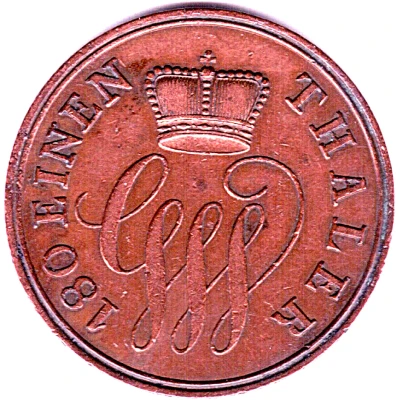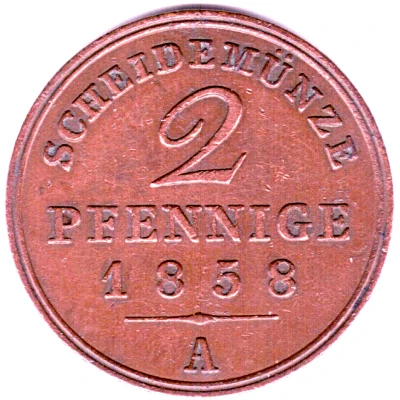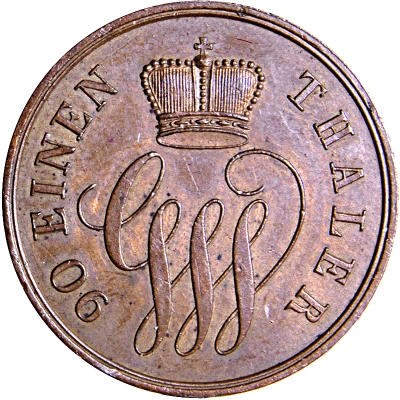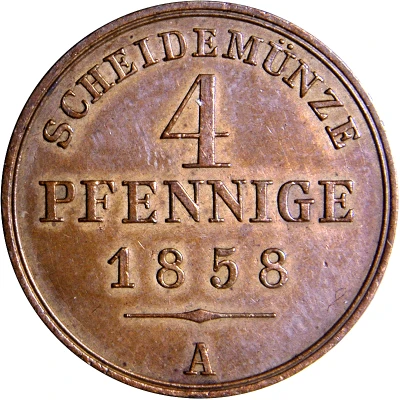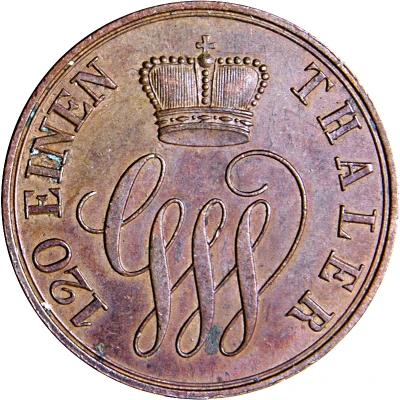
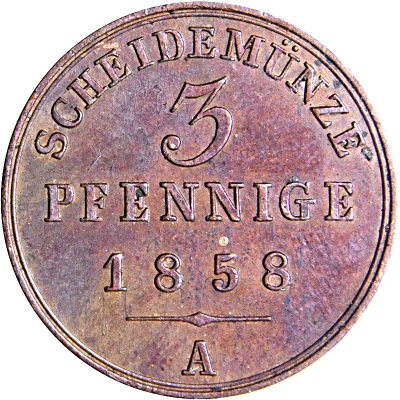

© Ulmo
3 Pfennige - George William
1858 year| Copper | 4.32 g | 24 mm |
| Issuer | Principality of Schaumburg-Lippe (Schaumburg-Lippe, German States) |
|---|---|
| Prince | George William (Georg Wilhelm) (1807-1860) |
| Type | Standard circulation coin |
| Year | 1858 |
| Value | 3 Pfennigs (3 Pfennige) (1⁄120) |
| Currency | Vereinsthaler (1857-1873) |
| Composition | Copper |
| Weight | 4.32 g |
| Diameter | 24 mm |
| Thickness | 1.3 mm |
| Shape | Round |
| Technique | Milled |
| Orientation | Medal alignment ↑↑ |
| Demonetized | Yes |
| Updated | 2024-10-05 |
| Numista | N#19527 |
|---|---|
| Rarity index | 49% |
Reverse
Name and date.
Script: Latin
Lettering:
SCHEIDEMÜNZE
3
PFENNIGE
1858
A
Edge
Plain
Comment
Schaumburg-Lippe, also Lippe-Schaumburg, was created as a county in 1647, became a principality in 1807, a free state in 1918, and was until 1946 a small state in Germany, located in the present day state of Lower Saxony, with its capital at Bückeburg.History
Schaumburg-Lippe was formed as a county in 1647 through the division of the County of Schaumburg by treaties between the Duke of Brunswick-Lüneburg, the Landgrave of Hesse-Kassel and the Count of Lippe. The division occurred because Count Otto V of Holstein-Schaumburg had died in 1640 leaving no male heir. Initially Schaumburg-Lippe's position was somewhat precarious: it had to share a wide variety of institutions and facilities with the County of Schaumburg (which belonged to Hesse-Kassel), including the representative assembly and the highly productive Bückeberg mines, and the Landgrave of Hesse-Kassel retained some feudal rights over it. It was further threatened by the headstrong policies of ruling Count Friedrich Christian. To counter these threats, Friedrich's grandson Count Wilhelm (who reigned 1748–1777) retained a standing army of up to 1000 troops - quite a lot for such a small territory.
With Wilhelm's death in 1777 the junior Schaumburg-Lippe-Alverdissen inherited the County thereby reuniting Schaumburg-Lippe with Lippe-Alverdissen.
Schaumburg-Lippe was a county until 1807 when it became a principality; from 1871 it was a state within the German Empire. In 1913, it was the smallest state in the German Empire in terms of population. The capital was Bückeburg, and Stadthagen was the only other town. Under the constitution of 1868, there was a legislative diet of 15 members, 10 elected by the towns and rural districts and 1 each by the nobility, clergy and educated classes, the remaining 2 nominated by the prince. Schaumburg-Lippe sent one member to the Bundesrat (federal council) and one deputy to the Reichstag. It lasted until the end of the German monarchies in 1918, when it became a free state as the Free State of Schaumburg-Lippe. In November 1918, Prince Adolf was the second last reigning German monarch to abdicate.
Interesting fact
The 3 Pfennige coin from the Principality of Schaumburg-Lippe, issued in 1858 during the reign of George William, features an interesting design element - a crowned shield with the coat of arms of the principality on one side, and the number "3" on the other. This design was unique to this particular coin and was not used on any other coins issued by the principality.
Price
| Date | Mintage | VG | F | VF | XF | AU | UNC |
|---|---|---|---|---|---|---|---|
| 1858 A | 360000 | - | - | - | - | - | - |
Values in the table are based on evaluations by sales realized on Internet platforms. They serve as an indication only for 3 Pfennige - George William 1858 coin.
